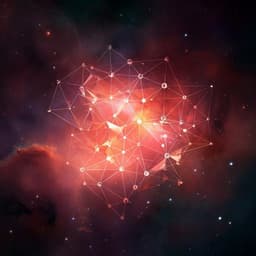
Computer Science
Accelerating network layouts using graph neural networks
C. Both, N. Dehmamy, et al.
Discover how Csaba Both, Nima Dehmamy, Rose Yu, and Albert-László Barabási have used Graph Neural Networks to revolutionize network visualization, achieving remarkable speed improvements for large networks while enhancing layout informativity.
~3 min • Beginner • English
Introduction
The study addresses the limitations of standard force-directed layout (FDL) algorithms used for network visualization, specifically their O(N^2) per-iteration cost on dense graphs and practical inefficiency even with Barnes-Hut approximations, which restrict visualization to relatively small graphs and often yield high-energy, visually uninformative "hairball" layouts. The research question is whether graph neural networks (GNNs) can reparameterize and accelerate the FDL optimization to both reduce computation time and achieve lower-energy, more interpretable layouts. The context spans widespread use in systems biology, ecology, social sciences, and beyond, where tools like Cytoscape and Gephi are widely adopted but limited for large networks. The purpose is to develop and analyze a GNN-based layout method that preserves the physical intuition of FDL while improving convergence speed and quality, enabling reliable visualization of large real networks.
Literature Review
Existing visualization workflows rely on variants of force-directed layout (FDL), treating edges as springs and incorporating repulsive forces to avoid overlaps. Classical methods include Kamada-Kawai and Fruchterman-Reingold algorithms, with acceleration via Barnes-Hut leading to O(N log N) for repulsion, though elastic force computations remain costly for dense graphs. Widely used software such as Gephi and Cytoscape implement these approaches but are typically effective only for hundreds to a few thousand nodes. Attempts to visualize much larger real networks often produce high-energy, uninformative hairballs. Prior improvements from computational chemistry-inspired energy minimization and long-range repulsive potentials face computational challenges at scale. The paper positions GNNs (e.g., GCN, GAT, GN) as a means to reparameterize the optimization, leveraging network structure; related machine learning literature includes GCNs and graph networks for message passing and spectral filtering.
Methodology
The authors propose reparameterizing node positions X ∈ R^{N×d} as outputs of neural networks, replacing direct optimization of X in FDL with optimization over network parameters θ. Two architectures are introduced: (1) NodeMLP, which maps a random N×h embedding Z to d=3 via X=σ(ZW+b); and (2) NeuLay, a GNN-based approach that encodes graph structure using Graph Convolutional Networks (GCN). In NeuLay-2, two GCN layers are applied: G1=σ(f(A)ZW1) and G2=σ(f(A)G1W2), with f(A)=D^{-1/2}(A+I)D^{-1/2}. The embeddings Z, G1, and G2 are concatenated to form G=[Z|G1|G2], then projected to d=3 via X=σ(GW+b). Training is performed per-graph: rather than standard pretraining, θ is optimized anew for each layout by minimizing the FDL energy C(X)=VL+VNN with gradient descent, using the chain rule ∂θ_α/∂t=−ε Σ_i (∂X/∂θ_α)(∂C/∂x_i). The elastic term VL=1/2 Tr[X^T L X] uses the graph Laplacian L=D−A, and a short-range Gaussian repulsion VNN(X)=α_N Σ_{i,j} exp(−||x_i−x_j||^2/(4r^2)) is employed for computational efficiency. The approach improves computational efficiency primarily by reducing the number of iterations to convergence rather than per-iteration complexity. Theoretical analysis focuses on spectral properties: for graphs where L≈⟨k⟩I−A (e.g., lattices, RGG, SBM), early dynamics decouple across eigenmodes, with slow modes associated with leading (outlier) eigenvalues of A. NeuLay’s GCN layers amplify gradients along these outlier modes (via f(A)Z spectral weighting), accelerating convergence by projecting early onto principal components corresponding to large-scale structures (communities or regularities). Experiments compare FDL, NodeMLP, NeuLay, and NeuLay-2 on synthetic graphs (ER, BA, SBM, RGG) and real networks (WAN, PPI, Facebook, Internet AS-level), measuring wall-clock time and layout quality via final energy, cluster separation, and link-length distributions. Additional tests manipulate adjacency spectra using A_top (outliers) and A_bulk (bulk) to test causality of outlier modes in speedup.
Key Findings
- NeuLay-2 yields 10–100× faster convergence than traditional FDL across diverse networks while often achieving lower final energies (better layouts).
- Speedup scales with size and depends on topology: approximately N^{0.8} for 2D RGG, N^{0.3} for BA, and N^{0.2} for ER at fixed density; speedup decreases with increasing density.
- NeuLay-2 achieves the fastest energy convergence among tested neural architectures; two GCN layers are optimal versus one or more than two.
- Final energy improvements increase with network size; the ratio ΔE=E_FDL/E_NeuLay-2 grows with N, especially for BA and ER, indicating FDL’s trapping in suboptimal minima.
- Spectral analysis links speedup to outlier eigenvalues of A: (i) Speedup increases with the number of outliers (observed ~n^{0.9} for SBM and RGG); (ii) Removing outliers (using A_bulk) significantly reduces speedup; (iii) Using only outliers (A_top) attains comparable or higher speedup than using full A in graphs with multiple outliers. No difference is observed among A, A_top, A_bulk for ER/BA lacking outliers.
- Real networks in 3D (d=3): NeuLay-2 is an order of magnitude faster; e.g., 14× speedup for WAN (N=10,617, L=63,781) and 13× for PPI (N=18,448, L=322,285).
- Internet AS-level graph (N=22,963, L=48,436): NeuLay-2 converges faster and to significantly lower energy; FDL’s final energy is ~12% higher. Across 10 runs, results are consistent.
- Link-length distributions: FDL layouts have more long edges than NeuLay-2; within Louvain communities (36 detected), NeuLay-2 shows shorter internal link lengths and better spatial localization and separation of clusters than FDL.
- NeuLay-2 automatically accelerates slow modes by aligning with leading eigenvectors from the outset, improving both speed and interpretability without requiring prior spectral knowledge.
Discussion
Findings demonstrate that reparameterizing FDL with GNNs (NeuLay) substantially accelerates convergence and improves layout quality by targeting slow dynamical modes associated with leading eigenvectors (principal components) of the adjacency matrix. This enables clearer visualization of large networks, with improved community separation and fewer long edges, addressing practical limitations of traditional FDL which often yields high-energy, uninformative layouts. The method generalizes conceptually to other graph-based gradient-descent problems, including reaction-diffusion dynamics, epidemic steady-state computation, cascading failures, chip placement, and opinion dynamics, because the acceleration mechanism depends on spectral properties rather than specific forms of the repulsive potential. NeuLay’s ability to exploit large-scale structure is particularly advantageous in networks with community structure or local regularity (outlier eigenvalues), but it also consistently reduces energy relative to FDL even when outliers are absent.
Conclusion
The study introduces NeuLay, a GNN-parameterized force-directed layout method that achieves one to two orders of magnitude speed improvements and lower final energies across synthetic and real networks, enabling high-quality visualization of large graphs. Analytical and empirical results link the speedup to the number of outlier eigenvalues, validating that NeuLay accelerates convergence by amplifying slow modes associated with large-scale structure. Practical benefits include more interpretable layouts with clearer community separation and improved link-length distributions. Future directions include enhancing efficiency for extremely large graphs via symmetry- or hierarchy-exploiting GNN designs and scalable architectures (e.g., GraphSAGE, ClusterGCN-like approaches), and extending AI-based layout tools to physical networks with curved links, as well as to broader classes of graph-structured optimization and dynamical systems.
Limitations
- Computational efficiency is presently limited by GNN complexity; while faster than FDL, training per graph can still be expensive for exceptionally large networks.
- Models are retrained for each new graph/layout instance, adding overhead compared to one-time training paradigms.
- Short-range repulsive forces are used for tractability; while NeuLay does not require long-range forces to find good layouts in large graphs, certain baselines (e.g., FDL with long-range forces) can yield good layouts but may be computationally intractable at scale.
- The method does not assume prior knowledge of relevant eigenvalues, but its acceleration benefits are most pronounced in graphs with outlier eigenvalues (communities/local regularities).
Related Publications
Explore these studies to deepen your understanding of the subject.







